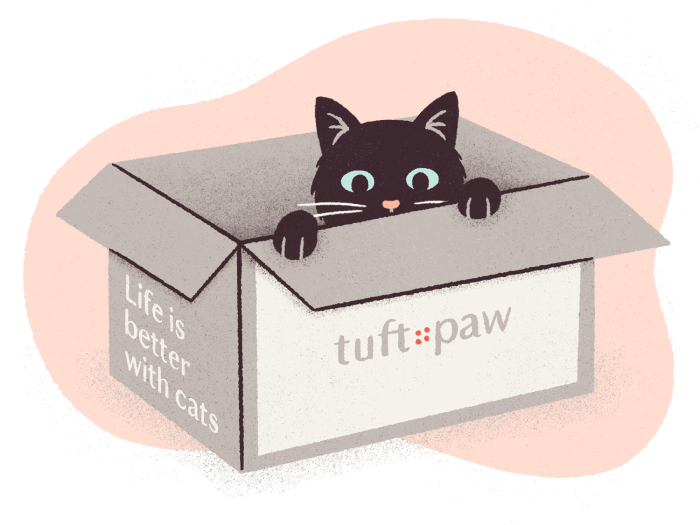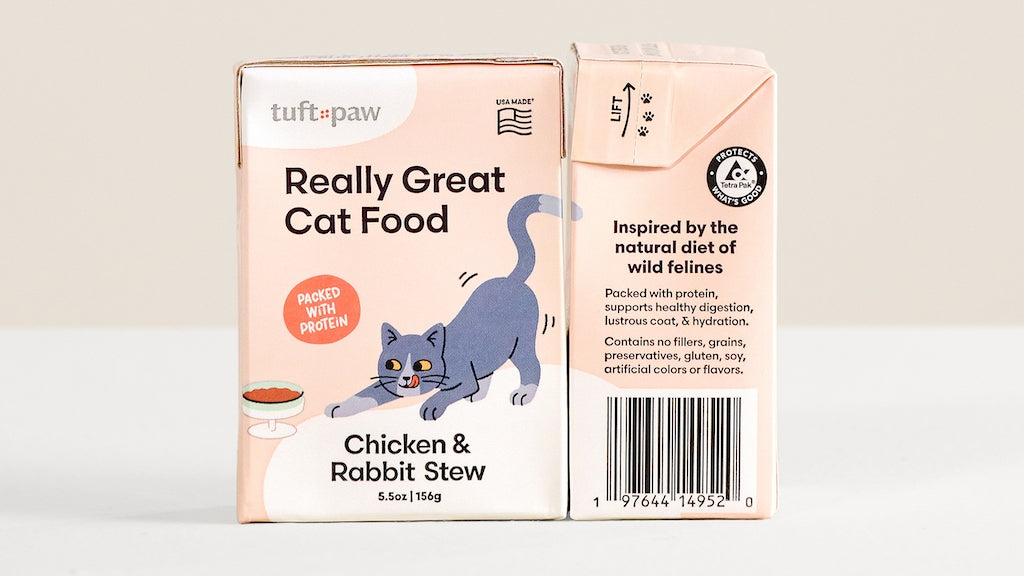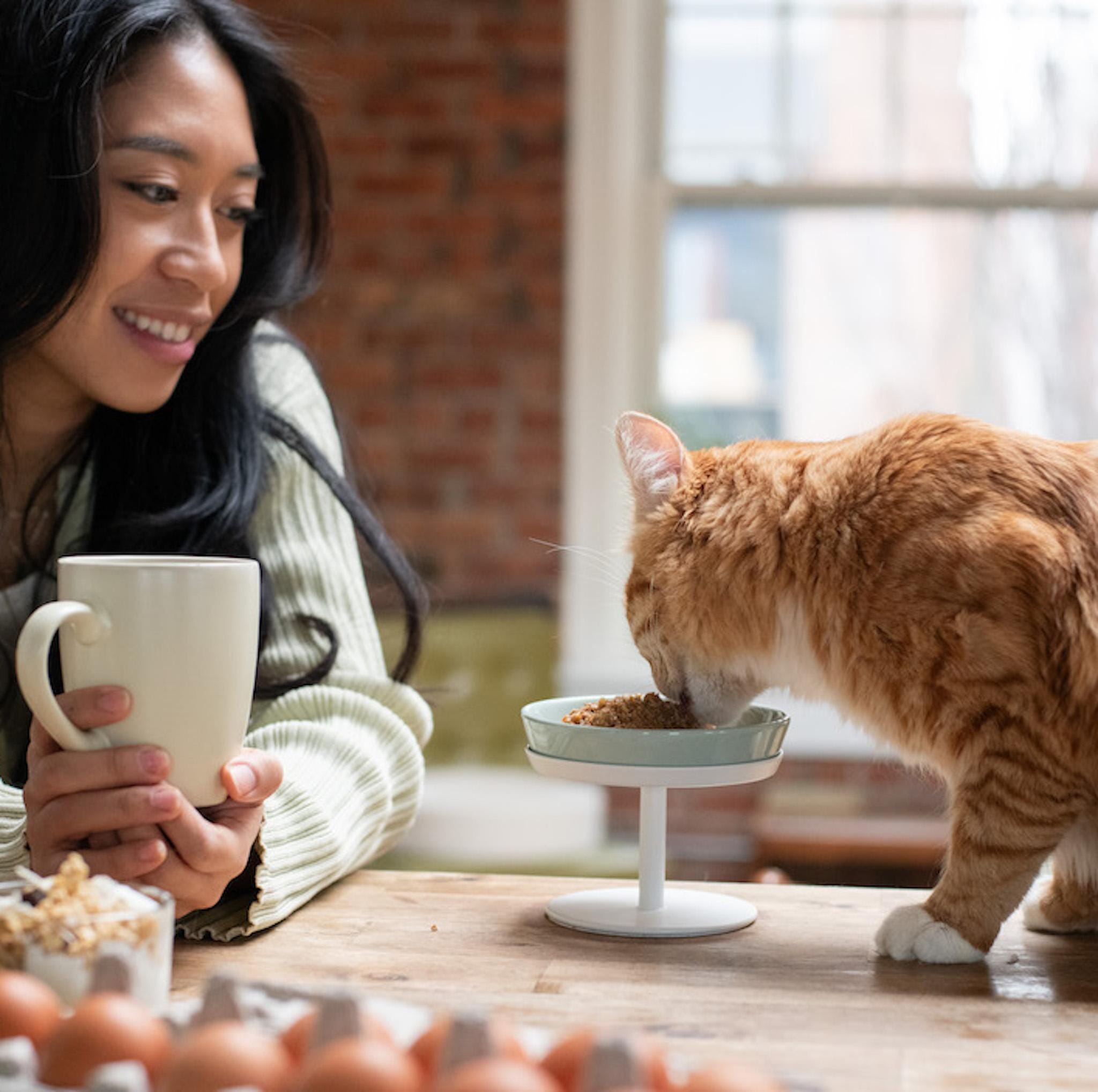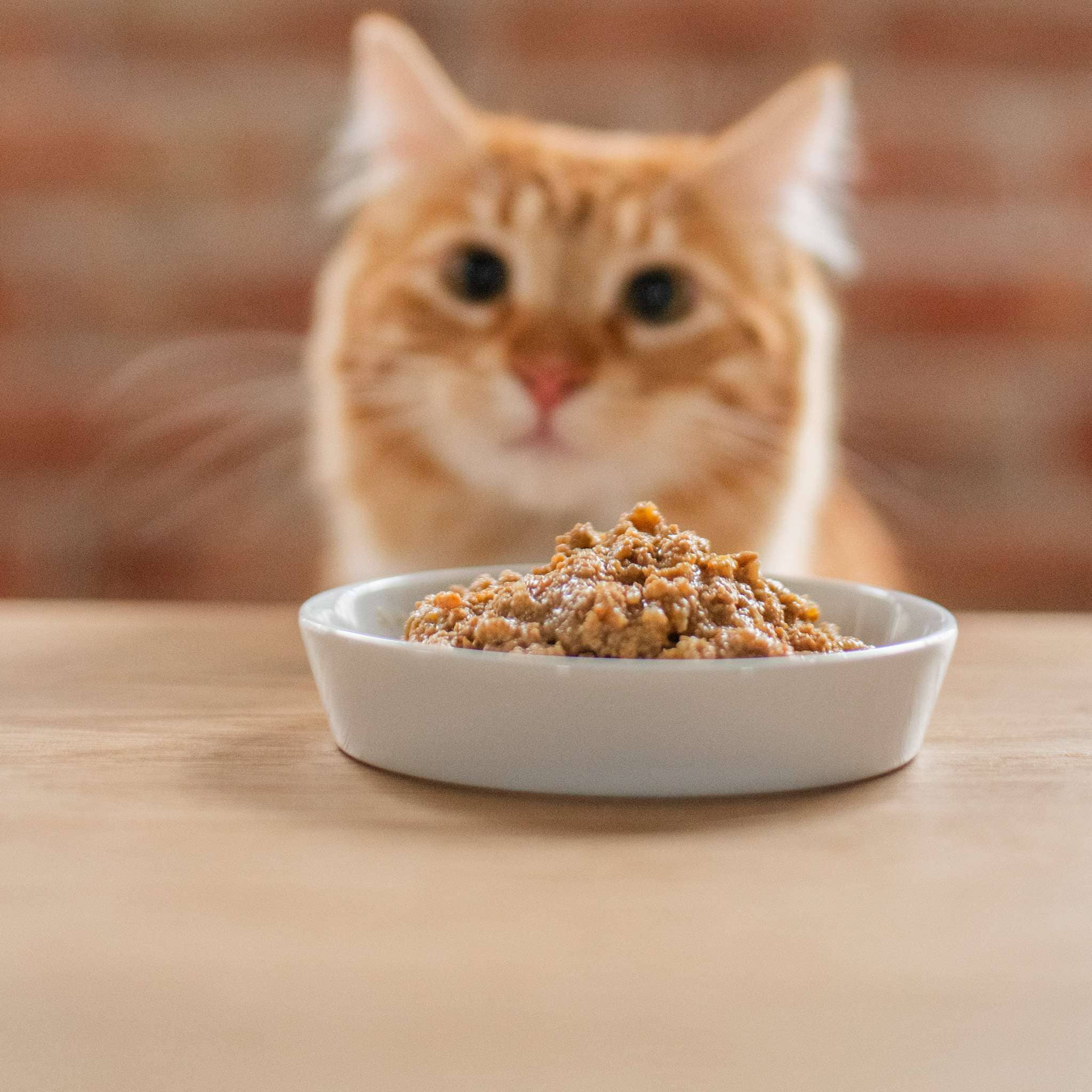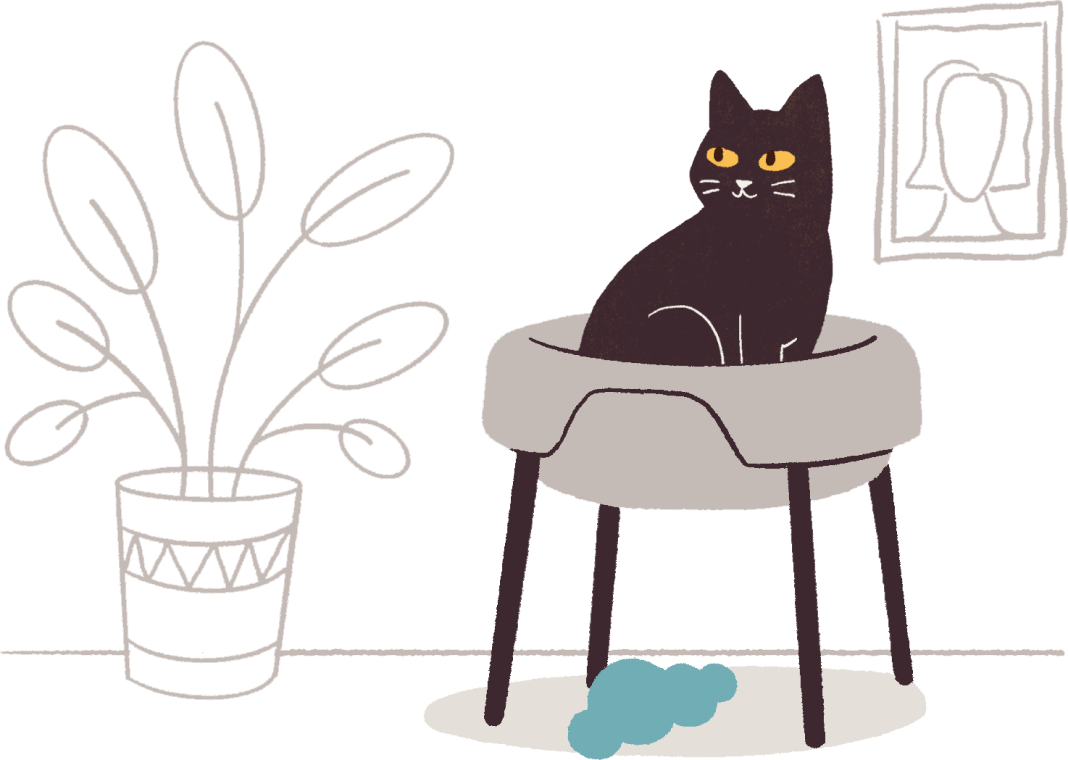As obligate carnivores, cats need a diet rich in animal protein with a relatively low carbohydrate content. But that begs the question: how can cat parents navigate this important issue when shopping for their kitty’s food? How much carbs is too much carbs? In this article, we’ll answer these key questions, discuss what to look for in a low carb cat food, and give you our picks for the best low carb cat foods on the market today.
Here at tuft + paw, we are cat experts. We're intimately familiar with the cat food features that are most important to cats and cat parents alike. This list is based on consultation with a feline nutritionist, veterinarian, hundreds of online reviews, and our own experience as cat parents.
Tip: For more specific food recommendations, see our lists of the best cat foods for sensitive stomachs and the best kitten foods.
Cheat Sheet: The Best Low Carb Cat Foods
1) tuft + paw Really Great Cat Food
| Pros | high quality animal protein, first 2 ingredients are chicken-based, low carbohydrates, no fillers, dietary fiber to aid digestion, salmon oil for omega-3s, affordable price point, high moisture content, human-grade ingredients |
| Cons | not available in pet stores |
| Calories | 138 cal/5.5 oz box = 25 cal/oz |
| Price | $69 for 24 x 5.5 oz box = $0.52/oz |
2) Tiki Cat After Dark Chicken & Quail Canned Cat Food
| Pros | high quality animal protein, first 6 ingredients are animal-based, low carbohydrates, no fillers, very high moisture content, tuna oil for omega-3s |
| Cons | low caloric density for kittens/mothers |
| Calories | 129 cal/5.5 oz can = 23 cal/oz |
| Price | $27.92 for 8 x 5.5 oz cans = $0.63/oz |
3) RAWZ Salmon Paté
| Pros | high quality animal protein, first 2 ingredients are fish-based, very low carbs, good moisture content, rich in omega-3s, affordable price point |
| Cons | not widely available |
| Calories | 198 cal/5.5-oz can = 36 cal/oz |
| Price | $2.90/5.5 oz can = $0.53/oz |
4) Nulo Freestyle Beef & Lamb Grain-Free Canned Cat Food
| Pros | high quality animal protein, first 6 ingredients are animal-based, low carbohydrates, high moisture content, affordably priced, menhaden fish oil for omega-3s |
| Cons | contains guar gum, not all cats like beef |
| Calories | 186 cal/5.5 oz = 34 cal/oz |
| Price | $54.96 for 24 x 5.5-oz cans = $0.42/oz |
5) Raised Right Original Turkey Adult Cat Food Recipe
| Pros | high quality animal protein, first 3 ingredients are turkey-based, very low carbohydrates, cod liver oil for omega-3s |
| Cons | pricey, low moisture content, food ships frozen |
| Calories | 687 cal/16-oz bag = 43 cal/oz |
| Price | $10.99 for 1 x 16-oz bag = $0.69/oz |
6) Koha Minimal Ingredient Chicken Stew for Cats
| Pros | high quality animal protein , first 2 ingredients are chicken-based, high moisture content, low carbohydrates, green mussel for omega-3s, affordable price |
| Cons | contains xanthan gum and veggie broth, low caloric density for kittens/mothers |
| Calories | 134 cal/5.5-oz can = 24 cal/oz |
| Price | $52.56 for 24 x 5.5-oz cans = $0.40/oz |
What is Low Carb Cat Food?
To be considered a low carb cat food and qualify for this list, a cat food should contain at most 15% carbohydrates on a dry matter basis. The best cat foods have a macronutrient balance of high protein, moderate fat, and low carbohydrates. Cat parents should note that there is no official standard for what counts as a low carb cat food.
Cats are obligate carnivores, meaning they depend on meat for their essential nutrients. Unlike dogs and humans, their digestive systems are not well-suited to absorbing nutrients from carbohydrates and dealing with lots of fiber. In the wild, a cat's diet would mostly consist of the prey they catch, with the main source of carbohydrates being their prey’s stomach contents. In most cases, cats would not be seeking out plant-based foods with a high carbohydrate content. Therefore, a commercial cat food with a low carb content aligns more closely with a cat's natural dietary needs, focusing on what their bodies are biologically adapted to process efficiently.
Tip: The best high protein cat foods should also be relatively low carb.
 Really Great Cat Food & Dock Bowl and Stand by tuft + paw
Really Great Cat Food & Dock Bowl and Stand by tuft + paw
Wet Cat Food vs Dry Cat Food
Wet cat food is typically higher in protein and lower in carbohydrates than dry kibble. If you’re looking to minimize the amount of carbs your cat is eating, then wet cat food is definitely the way to go. In general, wet cat food is much closer to the kind of food cats would be eating in the wild: animal protein and fats with a high moisture content and minimal carbs.
Of course, dry cat food does have its benefits, and ultimately it’s up to you to decide what kind of food is best for your cat. A good rule of thumb is to feed your cat primarily wet food, with a supplementary amount of dry food.
| Wet Cat Food | Dry Cat Food |
|
|
Guaranteed Analysis vs Dry Matter
Two terms you’ll often see when comparing wet cat foods are “guaranteed analysis” and “dry matter”. Here’s what they mean:
Guaranteed Analysis (GA) in Cat Food
When you look at a cat food label, you'll find the guaranteed analysis, providing the minimum/maximum percentage of key nutrients like protein, fat, fiber, and moisture. These percentages are presented on an as-fed basis, meaning it includes the moisture content in the formula.
Carbohydrates are not usually included in the guaranteed analysis. You can roughly estimate the maximum percentage of carbs in a cat food by adding up the percentages of protein, fat, fiber, and moisture, and subtracting those from 100%. The difference is a very rough estimate of the percentage of carbs the food could contain.
For example, let’s say a food has the following guaranteed analysis:
- Crude Protein (min): 10%
- Crude Fat (min): 5%
- Crude Fiber (max): 1.5%
- Moisture (max): 82%
Adding these percentages together: 10 + 5 + 1.5 + 82 = 98.5%.
Then subtracting from 100%: 100-98.5 = 1.5% carbohydrates.
If your food’s GA includes “Ash” content, subtract that number from 100 as well. Ash refers to the essential minerals added to the food, like potassium and calcium.
Note: Sometimes, guaranteed analysis percentages add up to more than 100%. This is because GA refers to the minimum/maximum percentage of each individual nutrient in the food, not the food as a whole. The actual percentages in a given can of cat food can vary, but will stay within the limits of the GA percentages.
Dry Matter in Cat Food
To make accurate comparisons between cat foods, especially when assessing nutrient density, you need to convert the guaranteed analysis to a dry matter basis. This requires removing moisture from the equation, providing a clearer picture of the actual nutrient composition.
“Dry matter” refers to the amount of certain nutrients found in a can of given cat food excluding water. Some brands provide dry matter nutrient breakdowns based on their average can of food (sometimes called “typical analysis”). These dry matter breakdowns will often include carbohydrates. When these numbers are not available, you can calculate the dry matter percentages using the guaranteed analysis.
 Really Great Cat Food & Dock Bowl by tuft + paw
Really Great Cat Food & Dock Bowl by tuft + paw
How to Calculate Dry Matter from Guaranteed Analysis
Here’s an example of how to estimate dry matter carb content from guaranteed analysis.
|
Food 1 |
Food 2 |
|
|
Food 1 is 82% water, so solid ingredients make up the remaining 18%.
Protein + fat + fiber = 16.5%, so we can estimate carbohydrates to make up 18-16.5 = 1.5% of the food on an as-fed basis. If carbs make up 1.5 out of 18 percentage points, we can estimate carbs on a dry matter basis like this: 1.5/18 = 0.083 = 8.3% carbs. This would qualify as a low carb cat food in our opinion.
Food 2 is 72% water, so solid ingredients make up the remaining 28%.
Protein + fat + fiber = 20%, so we can estimate carbohydrates to make up 28-20 = 8% of the food on an as-fed basis. If carbs make up 8 out of 28 percentage points, we can estimate carbs on a dry matter basis like this: 8/28 = 0.286 = 28.6% carbs. This would be a very high carbohydrate content.
Remember: This is a very rough way to estimate carb content in a cat food, not a precise calculation. For accurate numbers, look for a nutrient breakdown on the cat food brand’s website.
What to Look for In a Low Carb Cat Food
Minimal Carbohydrates (Under 15% Dry Matter)
Look for cat foods in which carbohydrates constitute less than 15% of the dry matter. This mimics cats’ diets in the wild, which are protein-focused and have minimal carbs (i.e. just what’s in their prey’s stomach). The feline digestive system is much better suited for digesting and absorbing nutrients from animal tissue than carbs. However, it's worth noting that some cats benefit from added dietary fiber to help prevent hairballs, which is a common feature of the best foods for indoor cats.
Tip: Check out our list of the best grain-free cat foods.
High Quality Animal Protein
Cats are obligate carnivores, meaning they rely on meat for their essential nutrients. Ensure that their cat food contains high quality animal-based protein sources as the first ingredients. Avoid foods that rely on animal byproducts, animal meals, or plant proteins for their protein content, as these are less digestible.
Healthy Animal Fats
A healthy cat’s diet should have high protein, low carbs, and moderate fats. Fats are super energy dense and serve as a crucial energy source for cats. Look for low carb cat foods with a decent amount of healthy animal fats, contributing to overall well-being and providing a satisfying meal. It’s also great to have a rich source of omega-3 fatty acids like salmon meat or cod liver oil, which reduce inflammation and contribute to a lustrous coat. Generally steer clear of foods that rely on plant oils for their fat content.
 Really Great Cat Food & Dock Bowl by tuft + paw
Really Great Cat Food & Dock Bowl by tuft + paw
Sufficient Moisture Content
Cats are notorious for not drinking enough water, so cat parents should always be aware of how much water their cat is getting. Cats have a low thirst drive so feeding them a high moisture food goes a long way in keeping them hydrated. Moisture also facilitates digestion and can help prevent other health complications like urinary stones.
Meets AAFCO Nutritional Standards & Life Stage Requirements
When selecting cat food, always check if it meets the nutritional standards set by the Association of American Feed Control Officials (AAFCO). This ensures that the food is formulated to provide a complete and balanced diet for your cat. AAFCO compliance is a crucial indicator of the food's quality and suitability for your cat's overall health.
Additionally, check the AAFCO statement on the label to ensure it’s appropriate for your cat's specific life stage. A cat’s different life stages have different nutritional requirements. For example, kittens need a higher calorie diet than adult cats to support their rapid growth, while senior cats benefit from diets that maintain muscle mass.
Here are the key AAFCO terms you’ll see on a label:
- Complete and Balanced – “Complete” means the product contains all the nutrients required. “Balanced” means the nutrients are present in the correct ratios.
- “Growth” life stage – Early life stage when kittens have greater nutritional needs to fuel their growth and development.
- “Maintenance” life stage – Adult cats who are no longer growing only require nutrition for maintenance of a healthy body weight.
- “Gestation/lactation” life stage – Pregnant/mother cats who need to feed their kittens have greater nutritional needs than non-pregnant, non-lactating adult cats.
- All life stages – This means the food is appropriate for both kittens and adult cats, though feeding directions will vary depending on your cat’s life stage.
Tip: Read about when to switch from kitten to cat food if you’re concerned about transitioning your young cat off of kitten food.
Our Criteria for Choosing the Best Low Carb Cat Food
- Low carbohydrate & plant content – All the foods on this list contain less than 15% carbohydrates on a dry matter basis.
- Meets AAFCO Standards – All foods on this list are formulated to meet the AAFCO Cat Food Nutrient Profiles for either adult cats or all life stages.
- High quality animal protein – All foods on this list prioritize animal proteins as their first ingredients rather than animal byproducts.
- Healthy fats – Quality cat food should contain healthy fats from animal sources, such as meat or fish oil.
- Moisture content – High moisture content in food helps cats avoid the health problems associated with dehydration.
- Price
Deep Dive: The Best Low Carb Cat Foods
1) tuft + paw Really Great Cat Food
Price: $69 for 24 x 5.5 oz box = $0.52/oz
Calories: 138 cal/5.5 oz box = 25 cal/oz
Life Stage: all life stages
Disclaimer: Yes, we included our own cat food here. This is because we truly think it performs excellently compared to other cat foods on the market. We subjected it to the same scrutiny as every other food on this list and asked for honest opinions from experts and cat parents.
Our pick for the best low carb cat food is tuft + paw’s Really Great Cat Food. It’s a great all-around recipe that checks all the boxes we look for in cat food. This formula prioritizes easily digestible animal protein with chicken as the primary meat source, and rabbit as a secondary source. Together these two meat sources provide essential amino acids and fatty acids, particularly taurine and arachidonic acid which are both especially vital to cats. The salmon oil provides a boost of omega-3s to aid immune function, reduce inflammation, and assist in brain and eye health. There are no filler carbs (e.g. starches, flours, potatoes), and each plant-based ingredient is there to provide either specific vitamins, minerals, antioxidants, or dietary fiber. The high moisture content and lack of gums facilitate digestion and keep things running smoothly in the GI tract. Cat parents will also appreciate the convenient subscription service and affordable price tag of $0.52/oz.
|
Ingredients: chicken, chicken broth, pumpkin puree, rabbit, carrots, ground golden flaxseed, natural flavor, tricalcium phosphate, agar-agar, salmon oil, dandelion greens, potassium chloride, vitamins , magnesium amino acid chelate, choline chloride, taurine, minerals , sea salt. |
|
Guaranteed Analysis
|
Dry Matter Analysis
|
| Pros | Cons |
|
|
2) Tiki Cat After Dark Chicken & Quail Egg Canned Cat Food
 Credit: Chewy
Credit: Chewy
Price: $27.92 for 8 x 5.5 oz cans = $0.63/oz
Calories: 129 cal/5.5 oz can = 23 cal/oz
Life Stage: all life stages
Tiki Cat After Dark Chicken & Quail Egg Cat Food is our runner-up for the best low carb cat food on the market. The first six ingredients are all easily digestible animal-based proteins, which contribute to the 66.6% crude protein content of this food (on a dry matter basis). Judging from the ingredients list, there are no plant ingredients and minimal carbohydrates. Of course, we also appreciate the tuna oil for omega-3s and the 82% moisture content, which will help keep your cat hydrated even if they don’t frequent their water bowl.
There aren’t any major drawbacks to this food, but at $0.63/oz it could become a little expensive for some cat parents. This slightly higher price point is the reason it's our number two pick instead of number one.
|
Ingredients: Chicken, chicken broth, quail egg, chicken liver, chicken gizzard, chicken heart, tricalcium phosphate, potassium chloride, choline chloride, magnesium sulfate, salt, taurine, ferrous sulfate, thiamine mononitrate (vitamin B1), vitamin E supplement, tuna oil, niacin (vitamin B3), zinc oxide, vitamin A supplement, biotin, vitamin B12 supplement, copper amino acid chelate, manganous oxide, calcium pantothenate, riboflavin supplement (vitamin B2), sodium selenite, pyridoxine hydrochloride (vitamin B6), folic acid, potassium iodide, vitamin D3 supplement |
|
Guaranteed Analysis
|
Dry Matter Analysis (GA estimate)
|
| Pros | Cons |
|
|
3) RAWZ Salmon Paté
 Credit: RAWZ
Credit: RAWZ
Price: $2.90/5.5 oz cans = $0.53/oz
Calories: 198 cal/5.5-oz can = 36 cal/oz
Life Stage: all life stages
RAWZ consistently offers high quality cat foods which prioritize animal protein and go easy on the carbs. This Salmon Paté recipe is a perfect example of that. Being a fish-based food, it’s rich in animal fats and especially omega-3 fatty acids. It’s also a good choice for indoor adult cats with its moderate caloric density and low fat recipe. We also like the reasonable price point.
The main inconvenience with RAWZ generally is that their foods are not available at major online retailers and big box stores. This can make it a bit annoying to track down if you don’t have a local pet store that stocks it. It’s also lower in protein than some other foods on this list, but it’s still sufficient and is overall a very healthy food.
|
Ingredients: Salmon, Fish Broth, Fenugreek Seeds, Dandelion Greens, Taurine, Natural Flavor, Tricalcium Phosphate, Potassium Chloride, Choline Chloride, Magnesium Proteinate, Zinc Proteinate, Iron Proteinate, Niacin Supplement, Vitamin E Supplement, Copper Proteinate, Sodium Selenite, Calcium Iodate, Thiamine Mononitrate, Manganese Proteinate, Vitamin A Supplement, Calcium Pantothenate, Riboflavin Supplement, Pyridoxine Hydrochloride, Salt, Biotin, Vitamin D3 Supplement, Vitamin B12 Supplement, Folic Acid. |
|
Guaranteed Analysis (as-fed)
|
Dry Matter Analysis (typical)
|
| Pros | Cons |
|
|
4) Nulo Freestyle Beef & Lamb Grain-Free Canned Cat Food
 Credit: Chewy
Credit: Chewy
Price: $54.96 for 24 x 5.5-oz cans = $0.42/oz
Calories: 186 cal/5.5 oz = 34 cal/oz
Life Stage: all life stages
Nulo Freestyle’s Beef & Lamb Cat Food is a great choice for cats who need a low carb recipe. There are several different protein sources: beef, turkey, whitefish, and lamb! We’re not cats, but this may give it a unique flavor that is appealing to cats who are picky towards other foods. There are no filler carbs, and just a few plant-based ingredients for added fiber, vitamins, and minerals. We also like the reasonable price point, which comes in at $0.42/oz if you get the 24-pack.
In terms of weaknesses, we don’t love that this food contains guar gum—a thickener that’s not very suitable for cat digestion. There’s also the fact that some cats don’t like beef and it’s not a protein source they would be eating in the wild. This is why we recommend it as an alternative if your cat rejects other types of food.
|
Ingredients: Beef, Beef Liver, Turkey, Beef Broth, Whitefish, Lamb, Natural Flavor, Guar Gum, Potassium Chloride, Agar Agar, Choline Chloride, Taurine, Cranberries, Pumpkin, Menhaden Fish Oil (Preserved With Mixed Tocopherols), Tomato, Dried Kelp, Yucca Schidigera Extract, Salt, Manganese Sulfate, Iron Proteinate, Sodium Carbonate, Zinc Proteinate, Thiamine Mononitrate, Vitamin E Supplement, Copper Proteinate, Manganese Proteinate, Sodium Selenite, Niacin Supplement, d-Calcium Pantothenate, Pyridoxine Hydrochloride, Riboflavin Supplement, Vitamin A Supplement, Biotin, Potassium Iodide, Vitamin D3 Supplement, Vitamin B12 Supplement, Folic Acid, Rosemary Extract. |
|
Guaranteed Analysis
|
Dry Matter Analysis (Typical)
|
| Pros | Cons |
|
|
5) Raised Right Original Turkey Adult Cat Food Recipe
 Credit: Raised Right
Credit: Raised Right
Price: $10.99 for 1 x 16-oz bag = $0.69/oz
Calories: 687 cal/16-oz bag = 43 cal/oz
Life Stage: adult maintenance
Raised Right’s Original Turkey Adult Cat Recipe is a quality low carb cat food for discerning cat parents. The brand prioritizes simple ingredients and single protein sources. This recipe has turkey thigh, heart, and liver as the first three ingredients, which we love to see. The carbohydrate content is very low and the plant-based ingredients that are included have distinct health benefits. We like the inclusion of cod liver oil for omega-3s.
Raised Right has a few drawbacks, the first of which is price. As with most fresh cat foods, it may be pricey for some cat parents at $0.69/oz. The moisture content is also quite low for a wet food, so it’s unlikely that a cat could meet their hydration needs from this food alone. Some cats may not like the unusually dry texture if they’re used to wetter food. The food is shipped frozen and must be thawed before feeding, which can be a minor hassle for busy cat parents.
|
Ingredients: Turkey Thigh, Turkey Heart, Turkey Liver, Carrots, Blueberries, Organic Spearmint, Cod Liver Oil, Egg Shell Powder, Flaxseed Oil, Organic Dried Kelp, Taurine, Thiamine Mononitrate |
|
Guaranteed Analysis
|
Dry Matter Analysis
|
| Pros | Cons |
|
|
6) Koha Minimal Ingredient Chicken Stew for Cats
 Credit: Koha Pets
Credit: Koha Pets
Price: $52.56 for 24 x 5.5-oz cans = $0.40/oz
Calories: 134 cal/5.5-oz can = 24 cal/oz
Life Stage: all life stages
Koha’s Minimal Ingredient Chicken Stew is a hearty low carb formula which is sure to appeal to most cats (who doesn’t love chicken?). Chicken, chicken broth, and chicken liver are three of the first four ingredients, providing plenty of animal-based protein and fats. The green mussels are a rich source of omega-3s, and the 82% moisture content is excellent for keeping your cat hydrated. There are a few plant ingredients, but for the most part they provide nutritional benefits and fiber rather than filler calories. Finally, we like the affordable price tag of $0.40/oz.
Overall this food is an awesome low carb cat food for cat parents on a budget, but there are a couple drawbacks. First of all, we don’t love the inclusion of xanthan gum—a carb which is used as a thickener but isn’t nutritionally necessary for cats. There’s also vegetable broth along with chicken broth. This isn’t a big deal, but we’d prefer solely chicken broth. Lastly, it’s not very calorically dense for an “all life stages” food.
|
Ingredients: Chicken, Chicken Broth, Vegetable Broth, Chicken Liver, Porcine Plasma, Dried Egg Product, Dried Chickpeas, Xanthan Gum, Pumpkin, Calcium Carbonate, New Zealand Green Mussel, Salt, Sodium Phosphate, Potassium Chloride, Dandelion Greens, Taurine, Choline Chloride, Parsley, Cranberries, Dried Kale, Turmeric, Iron Proteinate, Zinc Proteinate, Ginger, Fenugreek Seed, Vitamin E Supplement, Thiamine Mononitrate, Copper Proteinate, Manganese Proteinate, Sodium Selenite, Niacin Supplement, d-Calcium Pantothenate, Pyridoxine Hydrochloride, Riboflavin Supplement, Vitamin A Supplement, Biotin, Potassium Iodide, Vitamin D3 Supplement, Vitamin B12 Supplement, Folic Acid. |
|
Guaranteed Analysis
|
Dry Matter Analysis
|
| Pros | Cons |
|
|
Low Carb Cat Food FAQs
What is considered a low carb content in cat food?
Low carb cat food typically contains less than 15% carbohydrates on a dry matter basis. This ensures the diet is aligned with a cat's natural, protein-centric nutritional needs.
Does wet cat food or dry cat food have lower carbohydrates?
Wet cat food is lower in carbohydrates and higher in protein than dry cat food, and is more similar to a cat’s natural diet of small mammals and birds. On the other hand, dry cat food has a longer shelf life, is more calorically dense, and can help with dental hygiene.
How do I compare the carbohydrate content in different cat foods?
To make accurate comparisons, convert the guaranteed analysis to a dry matter basis. This involves removing the moisture content, providing a clearer picture of the actual nutrient composition. Some brands may have dry matter analysis on their website.
Can low carb cat food be suitable for all life stages?
Yes, there are many low carb cat foods that meet the nutritional standards set by AAFCO for “all life stages”. Always check the product label for specific life stage recommendations.
Are grains bad in low carb cat food?
Grains in cat food aren't inherently harmful, unless your cat has a grain allergy (which is rare). While cats don't require carbs to survive, grains in small amounts can serve as supplementary sources of fiber, vitamins, and minerals.
Conclusion
Cats are little carnivores and they don’t really need carbs in their diet. Luckily, there are plenty of excellent low carb cat foods available that meet these nutritional requirements. Our favorite low carb foods are tuft + paw’s Really Great Cat Food, Tiki Cat’s After Dark Chicken & Quail Egg Cat Food and RAWZ Salmon Paté for their animal protein focus and lack of additives. Nulo Freestyle Beef & Lamb Cat Food is a good option for cats who don’t like the usual chicken recipes, while Raised Right’s Turkey Adult Cat Food is perfect for those who prefer fresh foods. Lastly, Koha Minimal Ingredient Chicken Stew for Cats is a good balance of low carb, quality protein, and affordable price. Try out a few different foods and see which one your cat likes best. Good luck!
